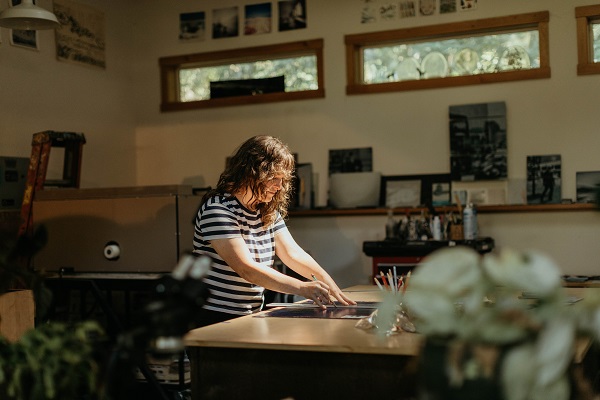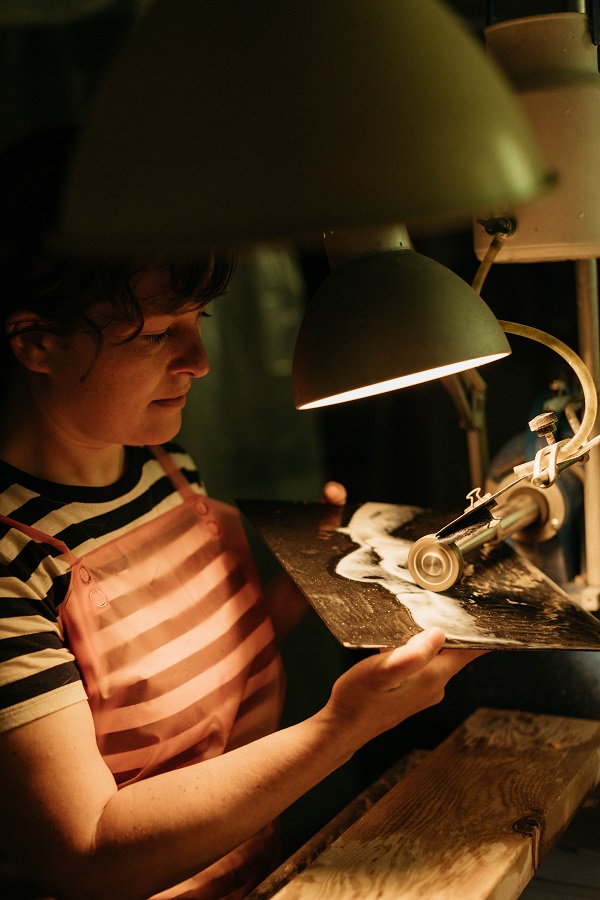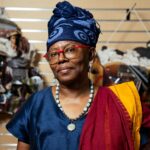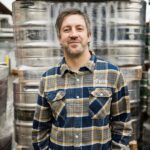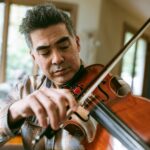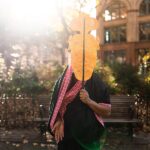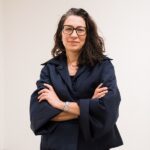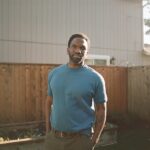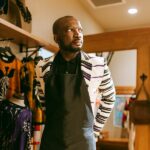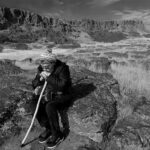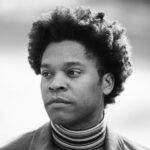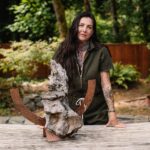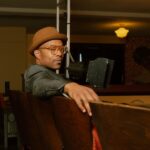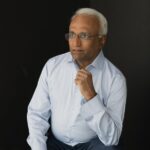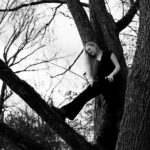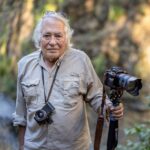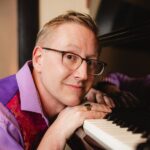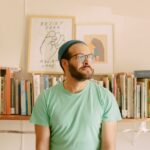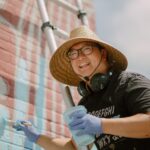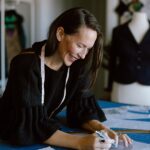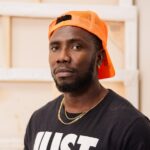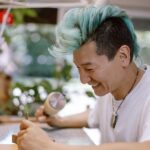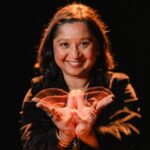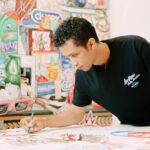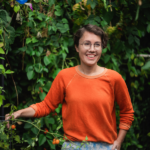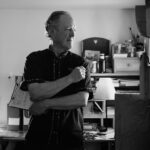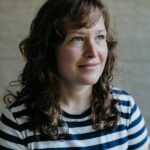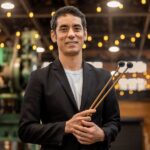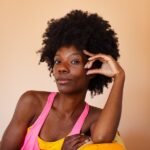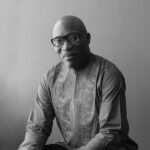Spiraling through Layers of Glass, Oceans, and Change
Written by Anne Liu Kellor; Photographed by Alyssa Teuton
In 2008, April Surgent was ingesting a series of radio programs and articles on climate change as she worked on a glass engraving for a show at the Bellevue Art Museum. This piece would take her over ten months to complete and become “Into the Surface”—a fourteen-foot wide by four-foot tall collage of 100 glass panels depicting seven people in shades of black, white, and gray, within an urban environment. The images in April’s work, whether human or non-human, at first glance can appear as blurred photographs. As you stand closer, however, you can see the three-dimensional, multi-layered quality to her engravings—alive with depth and movement.
At the time of this commission, April had been living in Hillman City, a neighborhood south of Seattle, reflecting on the sense of anonymity that one feels in urban landscapes, the loneliness that can pervade. The fractured nature of the 100 panels evokes this sense of how we, as humans, are both connected through our environment—and held apart. As she learned more about climate change, April started thinking about how this wasn’t “just some abstract future.” It was now.
“I felt terrified and overwhelmed,” she recalled. But she also remembered how her mentor, Jiří Harcuba—a Czech master engraver whom April met in 2003 and went on to study and teach with for ten years—had advised that “knowledge is the greatest agent for change. Instead of being afraid…go learn more about it.” And so she did.
Over a span of six years, from 2013 to 2019, April would go on to join expeditions in Antarctica, the Northwestern Hawaiian Islands, the Farallon Islands, and Southwest Alaska. April explained how “everything spiraled from the Antarctica trip,” where she’d been selected to be an artist-in-residence at Palmer Station in 2013. There, she met wildlife biologists who told her about a position with the Hawaiian Monk Seal Research Program, where she would volunteer as a field biologist in 2016, and make art—pinhole photography, daily drawings, writing—on the side.
“I was literally 1,200 miles from the nearest civilization with two other women on a 35-acre island in the middle of the ocean for five months,” April said of her time on Pearl and Hermes Atoll, which sits at the top of an ancient volcano and is critical habitat for the endangered Hawaiian monk seals. “It was incredibly remote…a ten-day rescue if anything were to happen. There was no resupply—all the water that we had we brought with us.” She describes this as her most profound travel experience, as if she were in “the womb of the planet, where life was literally boiling up from the ocean.”
This landscape gave her a “real sense of what it means to be a human, what it means to be somewhere…I wasn’t really supposed to be.” It was also a visceral confrontation with her own environmental impact, “because here I am in the middle of the ocean and it’s smothered in our freaking garbage.”
As she looked around and recognized all of the plastics on the beach—lighters, Crocs, nets that birds would be entangled in—April says, “I started really understanding just how much my individual actions actually make a difference, whether I’m able to reconcile those impacts or not.”
From an early age, April has listened to what moves her. She grew up in Kenmore, Washington, and came from a family of woodworkers. Her parents built a sailboat in their driveway, and she spent her childhood drawing and sketching near the Salish Sea. But it was a trip with her mom to Vancouver, B.C., at age fourteen, that first introduced her to what would become her primary genre: glass. Fascinated, April soon found a local glassblowing studio and got lessons for her fifteenth birthday. She continued to blow glass throughout high school and soon began to travel the world following her passion—first as an exchange student in Bornholm, Denmark, where she heard that glassblowing was thriving; then as a student at the College of Creative Studies in Detroit for a year; and finally transferring to study glass as an art major at the Australian National University in Canberra.
Continue Reading
In 2003, during her third year at ANU, April was awarded a scholarship to study at Pilchuck Glass School in Stanwood, WA, where she met her mentor, Jiří Harcuba. “I had played around with engraving before I met Jiří, but it was after his class that I found my own way with the process,” she recounted. After this encounter, April rarely blew glass again.
For ten years, April and Jiří would go on to work and teach together around the world, also writing letters back and forth. “I would write to him asking really specific questions about engraving and he’d write back about poetry or something,” April shared with a laugh. Twenty years later, in 2023, she would return to teach at Pilchuck, ten years after her mentor’s passing, completing another cycle of transmutation.
Now, April lives with her husband on five acres of land in Port Townsend, which they bought in 2012. They cleared and milled their own wood, built a studio/living space, and soon they will complete the building of a separate house to live in, finally giving April a dedicated studio for her engraving, a labor- and tool-intensive craft.
April’s process goes as follows: after the research phase, she sifts through her notes and digital pictures, often projecting them on the wall; then she works out a composition on paper before transitioning to glass. First, she fuses sheets of glass in kilns, layering together different colors. Then, she roughly sketches her composition on the surface, before using cutting and engraving lathes to remove each layer in a reductive process that reveals each new hue underneath.
For example, in “Strange Nights,” a cameo engraving from 2021, billowing gray and white clouds feel as if they are moving, illuminated by light and framed by darkened edges. Underneath the clouds rests a still body of water, with a thin layer of aqua green glowing along the horizon. From a distance, this piece might appear static. Up close, it breathes with light.
After April has fused her glass in the kiln and sketched her engraving on top, she then dons protective gear over her eyes, ears, mouth, and nose, before bringing the glass up to a grinding wheel, “like drawing, but taking the paper to the pencil.” For larger pieces she takes a hand grinder to the glass, which sits on a spinning table covered by a surface of water, which helps keep the dust down and the glass from cracking. Her husband, a metal fabricator, helped make the kick wheel table that turns the glass beneath her as she works. Since the tools don’t often exist for her artform, April has had to custom-order, make, and adapt other tools for her needs along the way.
These days, April doesn’t feel she needs to travel; instead she wants to dive deeper within herself and further explore the social aspect of the environmental crisis in her work. “It’s always a struggle to figure out: how do you talk about these things and make it impactful without making it depressing? I think a big mistake, besides politicizing climate change, is that we use these scare tactics, and nothing productive comes out of anything scary.”
April’s work asks of us: As artists, how do we translate the information we ingest from nature and science, in order to help create social change? And as humans, how can we tap into our individual strengths and come together as communities, collectively leaning into all that is both frightening and uncertain about the future of this planet, as we continue to be moved by its awesome beauty?
Like the grinding wheel, like the ocean tides that carry our debris to faraway places, and like each new encounter that brings forth our awe and respect for life, April Surgent’s journey from a teen finding her path in the Pacific Northwest to world traveler, artist, researcher, scientist, and activist, continues to spiral and turn. There are times we must settle deeply into one place, to pause, learn, and listen. And there are times we must move, connect, speak out, and create. As April’s practice has evolved, she has learned to merge ancient techniques with newly modified tools, leaning into what comes next. “I know that humans are incredibly adaptable and capable and smart. I know that it’s possible for humans to change,” she says. “We just have to decide that we want to do it.”


